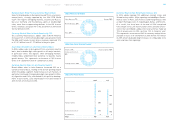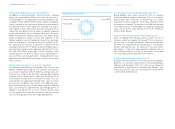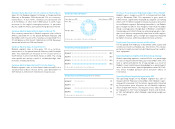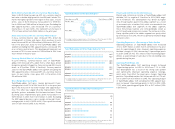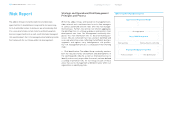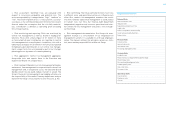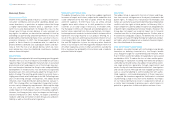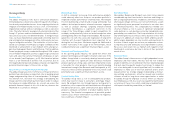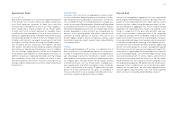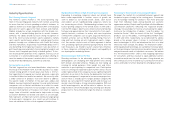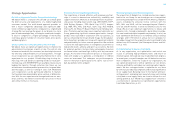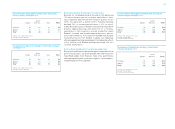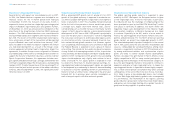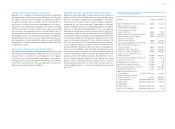Reebok 2006 Annual Report Download - page 103
Download and view the complete annual report
Please find page 103 of the 2006 Reebok annual report below. You can navigate through the pages in the report by either clicking on the pages listed below, or by using the keyword search tool below to find specific information within the annual report.Social and Environmental Risks
We have continuing responsibilities to our workers, suppli-
ers and the environment. Malpractice in these areas can have
a significant impact on the reputation and operational effi-
ciency of our Group and our suppliers. To limit this risk, we
have established workplace standards that suppliers must
meet before they can become our business partners (see
Sustainability, p. 63). Internal inspections of supplier facto-
ries verified by extensive external audits are conducted regu-
larly. In the event of non-compliance with these workplace
standards, we develop joint action plans and set deadlines for
compliance and further improvement. When these deadlines
are not met, business relations are terminated (see Sustain-
ability, p. 63
and www.adidas-Group.com/sustainability). We
regard the
risk of social and environmental malpractice as
likely in only isolated cases having a potentially low financial
impact.
Natural Risks
The adidas Group is exposed to external risks such as natu-
ral disasters, epidemics, fire and accidents. Further, physical
damage to our own or our suppliers’ premises, production
units, warehouses and stock in transit can lead to property
damage and business interruption. These risks are miti-
gated by ample loss prevention measures such as working
with reliable suppliers and logistics providers who guarantee
high safety standards and disaster recovery plans. In addi-
tion to the considerable insurance coverage we have secured,
the Group has also implemented contingency plans to mini-
mize potential negative effects. As a result, we expect an only
minor financial loss after insurance compensation should
natural risks materialize. However, we regard this scenario
as unlikely.
Financial Risks
Currency Risks
Most of the Group’s currency risks result from the fact that a
significant portion of our sourcing is done directly with sup-
pliers in Asia (see Global Operations, p. 60). This means the
products are invoiced mainly in US dollars, whereas our sales
to customers are denominated in multiple currencies such
as the euro, the Japanese yen, the Canadian dollar and the
British pound. Therefore, the Group is exposed to the risk
of exchange rate movements. We manage the risk through
centralized currency risk management and hedging of the
Group’s net US dollar deficit (see Treasury, p. 85). As we have
almost completed our anticipated hedging needs for 2007 at
rates slightly below those of 2006, we believe the likelihood
that currency risks could have more than a low impact on our
2007 financial contribution is low.
Interest Rate Risks
Significant interest rate changes can have an adverse effect
on the Group’s profitability, liquidity and financial position.
The acquisition of Reebok has led to an increase in interest
rate risks due to the higher financing requirements and the
resulting higher weighted average interest rate on the Group’s
financing structure (see Treasury, p. 85). To moderate interest
rate risks, floating-rate arrangements are partially protected
against short-term interest rate increases by corresponding
hedges such as fixed-rate interest rate swaps. Additionally, it
is part of our financial strategy to reduce the Group’s financial
leverage to below 50% in the medium term. We have strongly
reduced net debt following the financing of the Reebok acqui-
sition and have increased the share of fixed-rate financing
arrangements. As a result, we estimate the likelihood of
interest rate risks, which could have a medium effect on our
contribution in 2007 and the medium-term future, as low.
Investment Risks
In the past year, the adidas Group has primarily used free cash
flow to reduce borrowings which increased by approximately
€ 3 billion upon the purchase of Reebok. Therefore, only a very
limited amount of cash is invested in investment funds (see
Note 7, p. 157). Risks related to a major decline in the value of
these funds are therefore negligible in terms of likelihood and
potential impact.
Financing and Liquidity Risks
To meet our ongoing financing needs, the adidas Group faces
the risk of having to accept unfavorable financing terms due
to liquidity constraints. The Group, however, regards this risk
as limited as we have secured favorable conditions in the
financing arrangements for the Reebok acquisition. As we
anticipate strong free cash flow generation in 2007, we view
financing and liquidity risks as having both a low likelihood of
occurrence and low potential financial impact.
099


